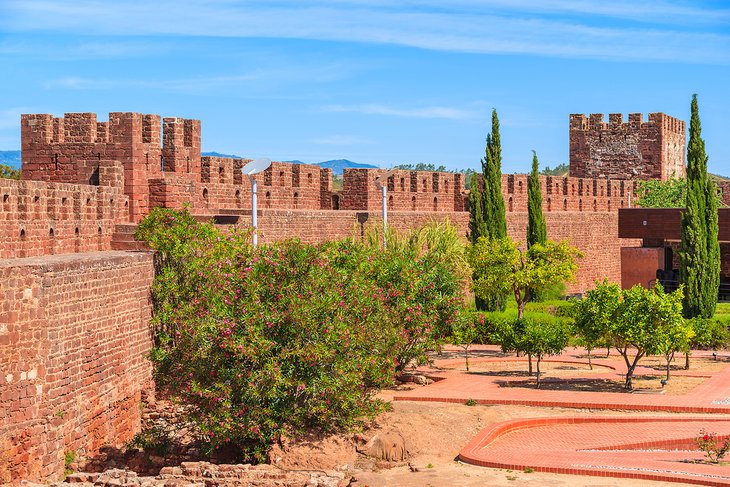
Travel attractions and car rental services in Portugal from CarRentalinPortugal.com: The majestic National Palace and Monastery of Mafra looms over the pleasant countryside town of Mafra and represents an outstanding example of grandiose excess. Work began in 1717 on what was originally supposed to be a simple monastery and basilica, commissioned by Dom João V to honor the birth of the king’s first child. But as wealth from Brazil swelled the royal coffers, the project took on a new dimension and eventually, a huge Baroque palace was built, lavishly decorated with exotic furnishings and numerous works of art. A tour allows access to the monastery, palace, church, and basilica. One of the undoubted highlights of the National Palace and Monastery of Mafra is the sumptuous marble floored library, where more than 40,000 rare and precious books line Rococo-style wooden bookcases – one of the most important collections of manuscripts and literature in Europe. If you are searching for a vehicle to travel between Portugal’s holiday destinations you can discover more information at https://www.carrentalinportugal.com/
The Portuguese city of Guimarães is the cultural and historical center of the country, and its main symbol is the medieval Guimarães Castle, which has become a historical landmark in Portugal. Today the castle has been restored and has hardly retained its original appearance. The fortress on the site of the castle, the hill of Monte Largo, was first erected in the 7th century. The modern look of the castle acquired much later – in the 12th century. Until the end of the 9th century, the area was under Arab rule and was called Vimaranesh. Later, when the Portuguese conquered the land, Count Diogo Fernandes became the owner of the fortress. At that time, a monastery was founded at the foot of the hill, a solitary donjon was erected and surrounded by a protective wall, and a small settlement sprang up around the cloister. The fortress gradually strengthened, grew and expanded.
Travel destinations and car rental services in Portugal 2023: Obidos Castle is an impressive structure that sits on a hill at Obidos, a small city that dates back to Roman times on Portugal’s Atlantic coast. The Moors built the castle sometime in the eighth century. It was remodeled around the 14th century and a keep was added. The castle today houses a luxury pousada hotel. A traditional medieval market takes place in the castle every July. Cais da Ribeira is a charming picturesque district in Porto, sometimes referred to as “the soul of Porto.” It’s made up of medieval streets that end on a square by the Douro River. Medieval buildings are filled with bars, cafes and restaurants, making Ribeira a popular place for eating and drinking. Ribeira is especially popular on feast days when townspeople flock there to see fireworks. There’s a bronze cube in the middle of the square. Nearby is the house where Prince Henry the Navigator was born in 1394.
Dominating the charming riverside town of Tomar is a mighty castle that shields the Convento do Cristo, one of Portugal’s standout historic attractions. Founded in 1160 as the headquarters of the Order of the Knights Templar, the Convent of Christ is as awe-inspiring as it is mysterious, its masonic heritage tangible and beguiling. At its center is the medieval Charola, the original Templar church, richly decorated and exuding all the strange symbolism associated with the Order of Christ. The 16th-century cloisters bewitch with Manueline flourishes and tease visitors with their concealed spiral staircases. And the convent’s magnificent Manueline window, designed by master sculptor Diogo de Arruda, remains one of the most architecturally appealing aspects of any building found in Portugal.
Travel destinations and rent a car services in Portugal right now: The castle itself attracts many tourists with its crenellated walls, preserved from the Middle Ages to the present day in remarkably good condition. The castle as we see it today was built in the 13th century and before that, during the Roman Empire, there were public baths and a square which played the role of political center of the settlement. After the fall of the Roman Empire, when the Visigoths came to power, a fortress was built on this site, around which the settlement was formed, the future city of Obidos. In the 8th century the fortress fell into the hands of the Muslims, and it was only in the 13th century that King Afonso of Portugal recaptured the edifice. Later, for several centuries, the fortress was a favorite place for royal festivities and celebrations.
Taking to the sea by kayak to explore the Lisbon coast makes for a rewarding maritime excursion. Besides offering an extra dimension to the sightseeing experience, paddling the coastline provides an excellent excuse to exercise in a salt-laced, pristine environment. Indeed, Lisbon’s proximity to the ocean allows for a wide range of exciting water sports, and discovering the beaches, bays, and coves set along the region between the Portuguese capital and the resort town of Cascais is a fun-packed way to enjoy a day out. Beyond the area, the crystal-clear waters off the Serra da Arrábida Natural Park, which encompass places like Setubal and Sesimbra, comprise a unique landscape of magnificent, ancient sea cliffs that teem with birdlife. Most of the coastline here lies within a protected marine reserve – a sanctuary that includes within its boundaries the wonderfully picturesque Ribeira do Cavalo beach. Find more info on carrentalinportugal.com.